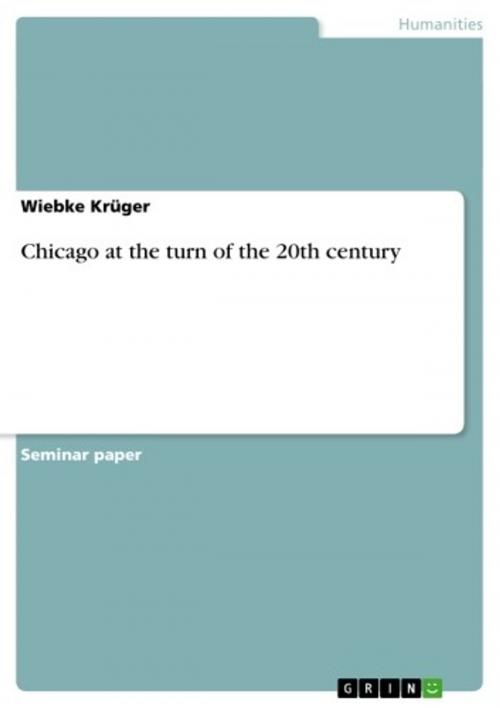Chicago at the turn of the 20th century
Nonfiction, Social & Cultural Studies, Social Science, Anthropology| Author: | Wiebke Krüger | ISBN: | 9783638695947 |
| Publisher: | GRIN Publishing | Publication: | April 15, 2007 |
| Imprint: | GRIN Publishing | Language: | English |
| Author: | Wiebke Krüger |
| ISBN: | 9783638695947 |
| Publisher: | GRIN Publishing |
| Publication: | April 15, 2007 |
| Imprint: | GRIN Publishing |
| Language: | English |
Seminar paper from the year 2004 in the subject Cultural Studies - Empiric Cultural Studies, grade: 1,3, Johannes Gutenberg University Mainz (Angewandte Sprach- und Kulturwissenschaft), 21 entries in the bibliography, language: English, abstract: When reading about Chicago at the Turn of the 20th Century, you always come across great changes and new developments in the means of transport, building and the stockyards; therefore, it can be assumed that these three fields influenced and shaped Chicago more than anything else in this period. The first chapter deals with the mostly very difficult daily life of Chicagoans, their cost of living and the wages they earned at that time; besides that, a passage will be dedicated to people's health conditions. Here, the focus lies on the poorer class of society which to a great extent consisted of immigrants who came to Chicago from all over the U.S. and Europe looking for jobs and hoping for a better life. When reading about the daily life of people it is very likely to come across the name Jane Addams, who helped the poor, and her Hull House. The second chapter is about the means of transport, especially about the importance of the railroad that made it possible for the city to have a great economic growth and provided an access way to the city for the many immigrants arriving in town. Moreover, the invention of the elevated railroad is mentioned and the changes in local transport that resulted from it. In the third chapter, Chicago's development in building is described. Due to the fact that the city was growing very quickly, people needed cheap houses that were easy to build. After the Great Fire of Chicago in 1871, architects from all over the country came to Chicago to rebuild what had been destroyed in the city center. Their greatest innovation was the modern skyscraper. Furthermore, there were two major building projects in Chicago at the turn of the century, the White City for the World's Columbian Exposition in 1893 and the Plan of Chicago. The third very important fact about the Chicago of the time, the stockyards, is described in chapter four. The stockyards are typical for this city and offered to thousands of Chicagoans a possibility to find work; they were also in every one's minds when thinking of Chicago and are representative for the problems of urban industrialization of that time. Chapter five gives an overview of an important event that ended tragically in 1886, the Haymarket Riot, during which workers went out on strike for an eight-hour working day. The last chapter deals with the name Pullman that has various meanings: a town, a railroad car, an industrialist.
Seminar paper from the year 2004 in the subject Cultural Studies - Empiric Cultural Studies, grade: 1,3, Johannes Gutenberg University Mainz (Angewandte Sprach- und Kulturwissenschaft), 21 entries in the bibliography, language: English, abstract: When reading about Chicago at the Turn of the 20th Century, you always come across great changes and new developments in the means of transport, building and the stockyards; therefore, it can be assumed that these three fields influenced and shaped Chicago more than anything else in this period. The first chapter deals with the mostly very difficult daily life of Chicagoans, their cost of living and the wages they earned at that time; besides that, a passage will be dedicated to people's health conditions. Here, the focus lies on the poorer class of society which to a great extent consisted of immigrants who came to Chicago from all over the U.S. and Europe looking for jobs and hoping for a better life. When reading about the daily life of people it is very likely to come across the name Jane Addams, who helped the poor, and her Hull House. The second chapter is about the means of transport, especially about the importance of the railroad that made it possible for the city to have a great economic growth and provided an access way to the city for the many immigrants arriving in town. Moreover, the invention of the elevated railroad is mentioned and the changes in local transport that resulted from it. In the third chapter, Chicago's development in building is described. Due to the fact that the city was growing very quickly, people needed cheap houses that were easy to build. After the Great Fire of Chicago in 1871, architects from all over the country came to Chicago to rebuild what had been destroyed in the city center. Their greatest innovation was the modern skyscraper. Furthermore, there were two major building projects in Chicago at the turn of the century, the White City for the World's Columbian Exposition in 1893 and the Plan of Chicago. The third very important fact about the Chicago of the time, the stockyards, is described in chapter four. The stockyards are typical for this city and offered to thousands of Chicagoans a possibility to find work; they were also in every one's minds when thinking of Chicago and are representative for the problems of urban industrialization of that time. Chapter five gives an overview of an important event that ended tragically in 1886, the Haymarket Riot, during which workers went out on strike for an eight-hour working day. The last chapter deals with the name Pullman that has various meanings: a town, a railroad car, an industrialist.















